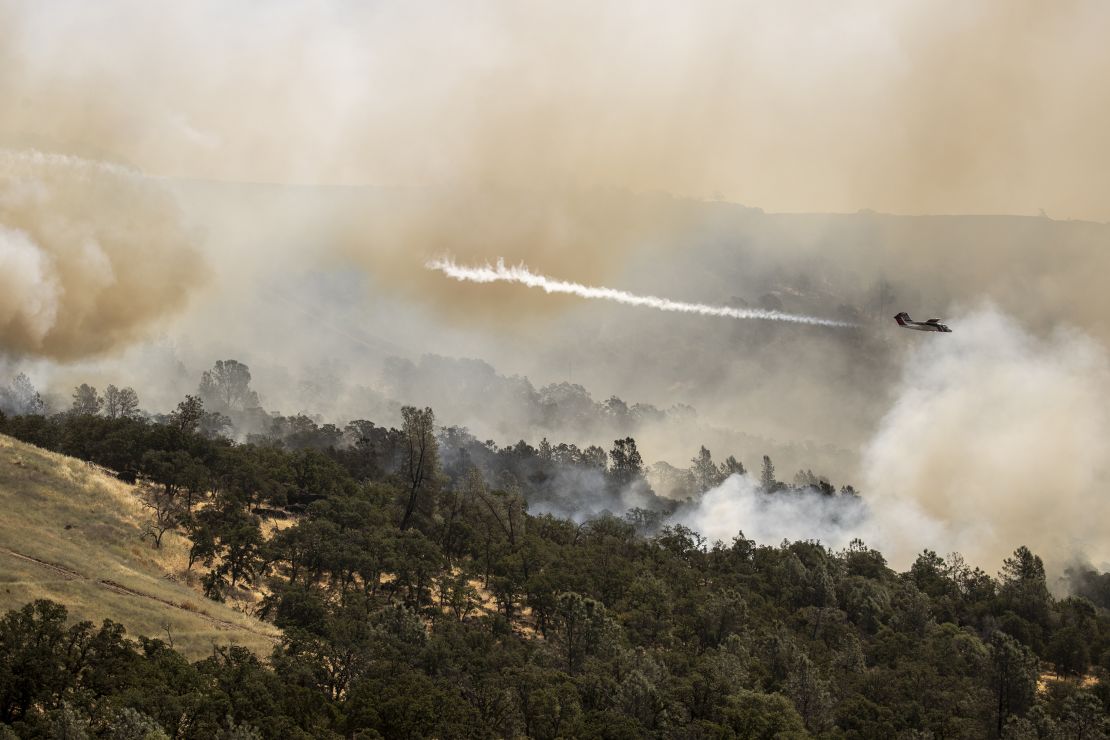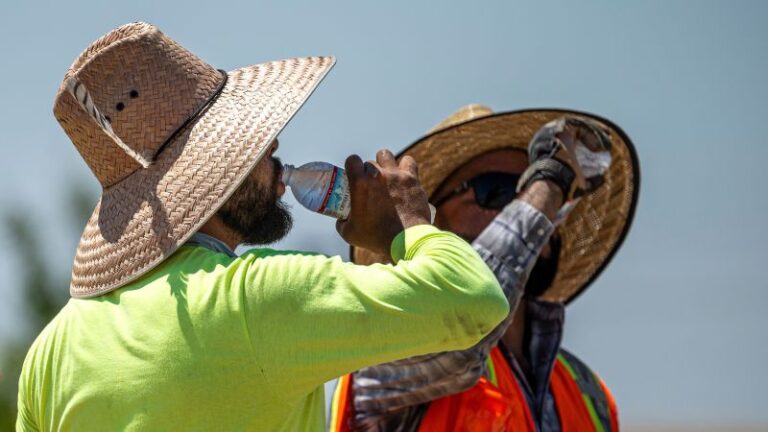CNN
—
An extremely dangerous and unusually long heat wave is intensifying and spreading across the West Coast, with no signs of abating for several days.
From California to Oregon, Washington, Nevada and Arizona, officials are preparing for possible wildfires, opening cooling centers and warning people to stay indoors and stay hydrated as an unrelenting heat wave pushes temperatures into the 100s to 110s Fahrenheit range, possibly reaching 120 in parts of the desert Southwest.
And the heat is only increasing.
Death Valley, California, could break its all-time record for the hottest day of the year by surpassing 125 degrees Fahrenheit by Sunday or Monday, and Las Vegas, Nevada, could also surpass its all-time high of 117 degrees Fahrenheit on Sunday or Monday.
“There is increasing confidence that this historic heatwave will continue for several days,” the National Weather Service in Portland warned, adding that the risk of heatstroke will increase significantly.
According to the National Weather Service, extreme heat is one of the leading causes of weather-related deaths in the United States, killing hundreds of people every year.
In San Jose, California, a homeless man died Tuesday as a result of the heat, Mayor Matt Mahan said. The man was 69 years old, mayoral spokeswoman Tasha Dean said, citing the Santa Clara coroner’s office.
The same day, a 10-year-old boy in Arizona died of heat stroke while hiking with his family in South Mountain Park Preserve, according to Phoenix police.
“These are dangerous conditions, especially for sensitive populations,” the National Weather Service in Los Angeles said, urging residents to never leave anyone in their cars, drink plenty of water, stay in the shade and wear light, loose-fitting clothing.
According to the National Weather Service, Saturday is likely to be the hottest day of the lingering heat wave, with high temperatures in the 110s Fahrenheit becoming the norm across California except along the coast and in the highlands.
“These heat levels continue to persist in parts of California’s Mojave Desert and Sacramento/San Joaquin Valleys and could be dangerous for anyone without proper heat protection measures,” the weather service said.
Around 140 million people across the country remain under extreme heat warnings, mainly in western states, with the heatwave expected to continue until the middle of next week.
Temperatures are expected to reach triple digits in parts of Oregon on Friday, with no overnight drop in temperatures and the heat could last for up to five days, according to the National Weather Service in Portland.
A state of emergency was declared in Multnomah County, Oregon’s most populous, as temperatures were expected to rise this weekend.
“We are especially concerned about the thousands of people heading to music festivals and sporting events this weekend who will be spending long periods outdoors with little shade or water sources and may not be aware of the risks,” Multnomah County Health Officer Dr. Richard Bruno said in a news release.
Bruno said the area has had few hot days so far this year and residents’ bodies are still getting used to the heat.
The 2021 heat wave in Oregon caused power generation equipment to fail, leading to rolling blackouts for tens of thousands of people and causing dozens of deaths as temperatures topped 100 degrees Fahrenheit.
While this latest heat wave is not expected to be as intense as the heatwave of 2021, forecasters are concerned about its prolonged duration, Noah Alvis, a meteorologist with the National Weather Service in Portland, Oregon, told CNN. “We’ll have four to five days of temperatures in the upper 90s Fahrenheit, or even above 100 to 105 degrees Fahrenheit, which is very unusual for this region,” Alvis said.
“Triple-digit heat will extend north into parts of the Pacific Northwest and central Great Basin, with widespread highs rising into the 90s to low 100s,” the National Weather Service said. “The duration of this heat is also of concern, as scorching, above-average temperatures are expected to continue into next week.”
More than a dozen temperature records were broken or tied on July 4th, including in several California cities, with temperatures reaching 110°F in Palmdale and 109°F in Madera.
The combination of extreme heat, gusty winds and low humidity means any wildfires that do break out can spread quickly through already dry vegetation.
Red flag warnings are in effect across the West, including for the Thompson Fire, which has burned more than 3,700 acres in Butte County, California, since it was reported Tuesday, forcing thousands of people to evacuate and leaving hundreds of firefighters battling blazes in scorching heat in the Oroville, California, area.
Eleven firefighters were injured in the blaze, eight of whom suffered heat stroke, said Chris Peterson, a spokesman for the California Department of Forestry and Fire Protection.
As of Thursday night, the fire was 29% contained, according to Cal Fire.
Fire season is ongoing in the state, with 144,940 acres burned so far in 2024, compared with 7,812 acres burned during the same period last year, according to Cal Fire.
According to Cal Fire, there are currently nearly 20 wildfires of various sizes burning across the state, with the Thompson Fire being the largest of them all.
“We have fires burning from the coast of San Diego to the foothills of Butte,” Cal Fire Deputy Chief Nick Schuler told CNN on Wednesday. “Firefighters are battling fires all across California, often on the ground for more than 24 hours. These are difficult conditions they face.”
The French Fire, a wildfire in Mariposa County, California, has burned about 400 acres northwest of the small town of Mariposa outside Yosemite National Park, prompting evacuation orders Thursday night, Cal Fire announced in a social media post.
The Mariposa County Sheriff’s Office announced Thursday night that shelter-in-place orders have been issued for two hotels near Yosemite National Park due to wildfires.
California Governor Gavin Newsom on Wednesday declared a state of emergency in areas affected by the Thompson Fire, paving the way for additional resources to be deployed, including the possible mobilization of the California National Guard to help.

As the West swelters, the unbearable heat and humidity will begin to move eastward into the Mid-Atlantic and Southeast over the weekend.
“Overnight temperatures will be warm, in the upper 70s to low 80s Fahrenheit, which will lead to dangerous conditions for those without adequate cooling facilities,” the National Weather Service said.
New heat warnings have been issued for parts of southeast Texas, far southern Florida, the northern Southeast and the Mid-Atlantic coast, with highs expected to range from 95 to 105 degrees Fahrenheit. Cities like Houston, Miami, Atlanta, Raleigh and Washington, D.C. will feel the heat.
The heat index in these areas — the feeling of the air on the human body — will range from 100 degrees to 115 degrees.
“A cold front moving into the Southern Plains is expected to bring below-normal temperatures through Friday across Oklahoma, much of north and west Texas and the Mid-South,” the weather service said in a statement.

